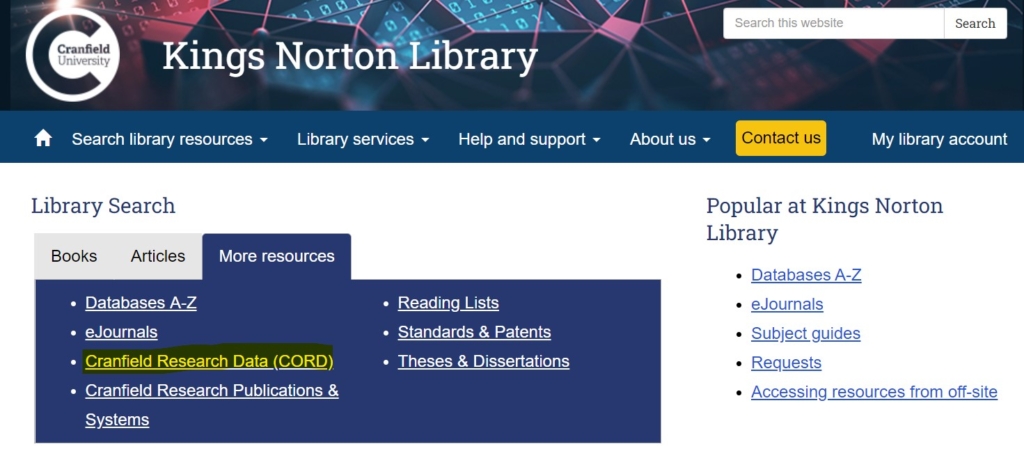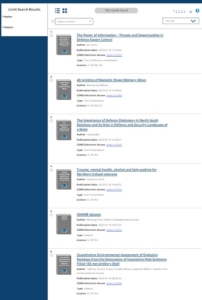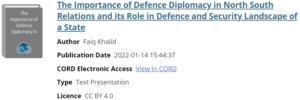CORD datasets are now available in Library Search
18/01/2022

Including research data in your research process can bring many benefits; these include greater visibility for data creators, a more transparent research process, and opportunities to identify potential collaborators. With the inclusion of CORD data sets within Cranfield’s Library Search it’s now possible to search for CORD data along with a range of other Library resources.
When referring to digitally born material, a dataset is a set of data, represented in any digital format, that together have a meaning. These sets of data are available for computer processing in one or more digital formats. Datasets are not just limited to being a matrix of text or numbers; they can also contain collections of sounds, images or videos, combining different forms of information (Vericad, 2019).
Datasets must also have accompanying documentation which explains their use and significance. Alongside the datasets you can discover in CORD, you will also find posters, presentations, software and conference contributions. All of these item types are accompanied by metadata that describes their relevance and often, too, details of the research publication associated with the data.
You can access Cranfield Research Data (CORD) by navigating to the home page of either the Kings Norton Library or Barrington Library and selecting this option under ‘More resources’.

When selecting the link above you will be presented with a current list of items available in CORD:

Individual records include information about the licence under which the item is made available. More information about Creative Commons Licences is available should you want to re-use any data. By clicking ‘View in CORD‘ you’ll be directed directly to the item’s record in Cranfield’s CORD data repository.

If you’d like to find out more, or for any questions you might have, please contact our Research Data team: researchdata@cranfield.ac.uk
Reference:
2019. JJ Boté Vericad. ‘Dataset Management as a Special Collection’. http://diposit.ub.edu/dspace/bitstream/2445/134797/1/690235.pdf
Photo by Kaleidico on Unsplash
Categories & Tags:
Leave a comment on this post:
You might also like…
Keren Tuv: My Cranfield experience studying Renewable Energy
Hello, my name is Keren, I am from London, UK, and I am studying Renewable Energy MSc. My journey to discovering Cranfield University began when I first decided to return to academia to pursue ...
3D Metal Manufacturing in space: A look into the future
David Rico Sierra, Research Fellow in Additive Manufacturing, was recently involved in an exciting project to manufacture parts using 3D printers in space. Here he reflects on his time working with Airbus in Toulouse… ...
A Legacy of Courage: From India to Britain, Three Generations Find Their Home
My story begins with my grandfather, who plucked up the courage to travel aboard at the age of 22 and start a new life in the UK. I don’t think he would have thought that ...
Cranfield to JLR: mastering mechatronics for a dream career
My name is Jerin Tom, and in 2023 I graduated from Cranfield with an MSc in Automotive Mechatronics. Originally from India, I've always been fascinated by the world of automobiles. Why Cranfield and the ...
Bringing the vision of advanced air mobility closer to reality
Experts at Cranfield University led by Professor Antonios Tsourdos, Head of the Autonomous and Cyber-Physical Systems Centre, are part of the Air Mobility Ecosystem Consortium (AMEC), which aims to demonstrate the commercial and operational ...
Using grey literature in your research: A short guide
As you research and write your thesis, you might come across, or be looking for, ‘grey literature’. This is quite simply material that is either unpublished, or published but not in a commercial form. Types ...






